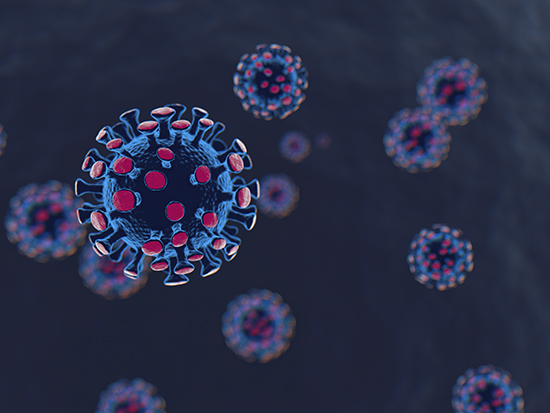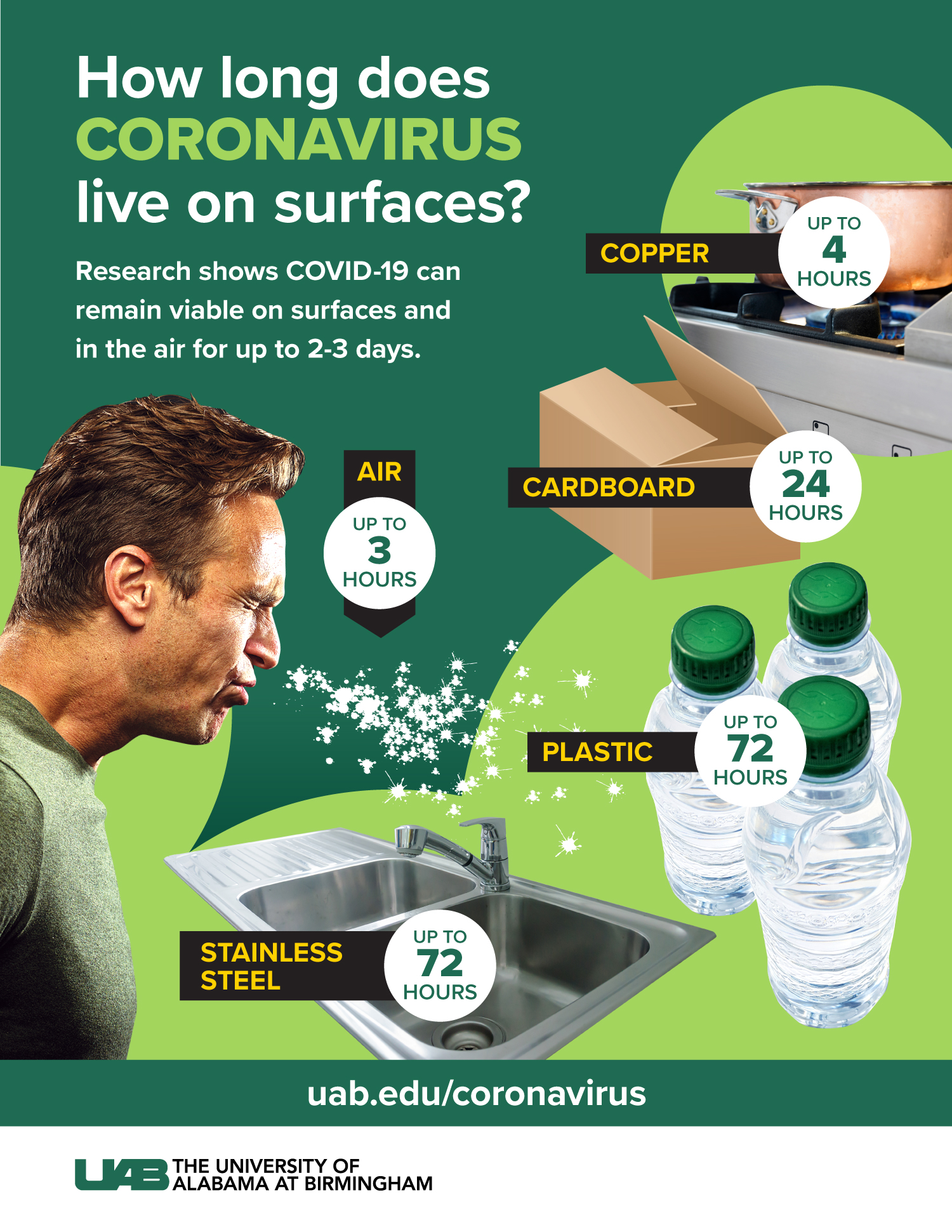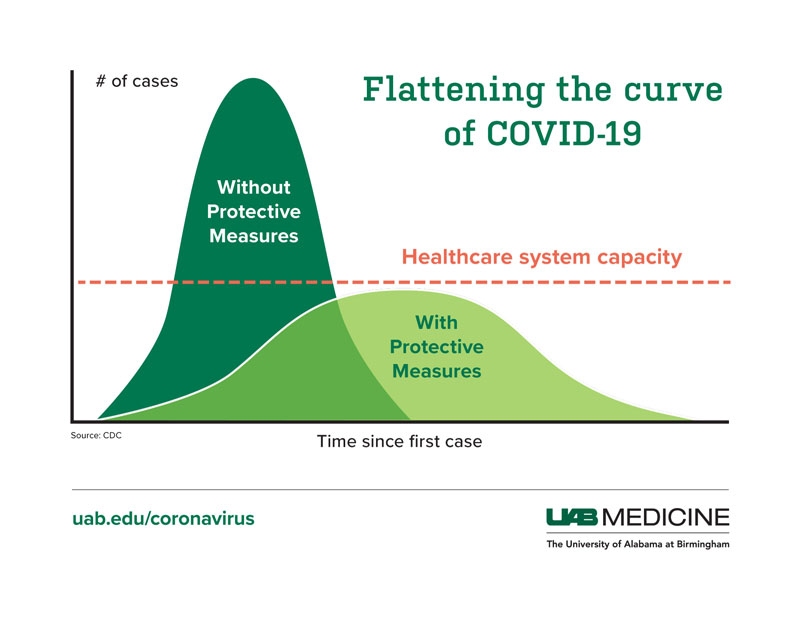Media contact: Holly Gainer
 The coronavirus crisis has introduced a lot of new words into daily vocabulary — words such as pandemic and asymptomatic and acronyms like PPE. All can be found in the dictionary or on websites for the Centers for Disease Control and Prevention, the Occupational Safety and Health Administration, and the American Red Cross. But what do they mean in everyday life?
The coronavirus crisis has introduced a lot of new words into daily vocabulary — words such as pandemic and asymptomatic and acronyms like PPE. All can be found in the dictionary or on websites for the Centers for Disease Control and Prevention, the Occupational Safety and Health Administration, and the American Red Cross. But what do they mean in everyday life?
The University of Alabama at Birmingham’s Bertha Hidalgo, Ph.D., associate professor in the School of Public Health’s Department of Epidemiology, has translated some of coronavirus’s most-used terminology to help citizens better understand how the disease spreads and what can be done to stop it.
Virus vs. bacteria vs. germs
How Merriam-Webster defines virus: submicroscopic infectious agents, usually regarded as nonliving extremely complex molecules, that typically contain a protein coat surrounding an RNA or DNA core of genetic material but no semipermeable membrane, that are capable of growth and multiplication only in living cells and that cause various important diseases in humans, animals and plants.
How Merriam-Webster defines bacteria: single-celled prokaryotic microorganisms that typically live in soil, water, organic matter, or the bodies of plants and animals and that make their own food.
How Merriam-Webster defines germs: a small mass of living substance capable of developing into an organism or one of its parts.
What they mean during coronavirus: “Viruses and bacteria are types of germs,” Hidalgo said. “Bacteria are bigger than viruses and can live without a host, since they get their nutrients from their environments, and some are actually good for us, like the ones that keep our gut working well. Viruses are pretty simple, actually — they are just little balls of genetic material surrounded by a protein coating. They tend to be smaller than bacteria and need a host to live. The COVID-19 virus is surrounded by a greasy covering, which can be broken down by soap. That’s why handwashing is so important for combating the virus, because it breaks it apart.”
Epidemic vs. pandemic
How Merriam-Webster defines an epidemic: an outbreak of disease that spreads quickly and affects many individuals at the same time.
How Merriam-Webster defines a pandemic: an outbreak of a disease that occurs over a wide geographic area and affects an exceptionally high proportion of the population.
What they mean during coronavirus: “An epidemic is the sudden, fast spread of a disease,” Hidalgo said. “In the case of COVID-19, we first noticed an epidemic in Wuhan, China. As it spread outside Wuhan and beyond national borders into other countries, the epidemic became a pandemic — a widespread, worldwide spread of disease.
 Asymptomatic
Asymptomatic
What Merriam-Webster says: presenting no symptoms of disease.
What it means during coronavirus: “This is an interesting term — it’s been associated with mild symptoms, when the word actually means to be ‘without’ symptoms. In the context of COVID-19, it means a period of time when someone has the virus and is able to infect others and make them sick, but may not feel any symptoms, or perhaps has symptoms so mild that they are missed entirely — things like infrequent sneezes, loss of smell or taste, or perhaps a light, dry cough.”
Droplets/aerosols
How Merriam-Webster defines droplets: a tiny drop, as of a liquid.
How Merriam-Webster defines aerosols: a suspension of fine solid or liquid particles in gas.
What they mean during coronavirus: “Droplets are mucus or saliva that come out of the mouth and nose when you cough or sneeze. They contain the COVID-19 virus and can land on people or surfaces,” Hidalgo said. “Aerosols tend to be smaller than 0.0001 millimeters, which is really small — a ballpoint pen tip is about 0.1 millimeters. The New England Journal of Medicine says they can be suspended in the air for up to three hours. Droplets tend to be bigger, and because of that, they travel less distance when sneezed or coughed out and are more likely to fall on the ground than on a person or surface.”
Community spread
How Merriam-Webster defines it: the spread of a contagious disease to individuals in a particular geographic location who have no known contact with other infected individuals or who have not recently traveled to an area where the disease has any documented cases.
What it means during coronavirus: “There are two types of coronavirus spread that happened in the United States: travel-related and community spread. The first means people who were infected traveled to the United States and infected others. Community spread then happens when people who were infected by people who traveled begin infecting others, who then infect even more people. Eventually, so many people are infected within a community that it is difficult to determine who is infecting whom.”
Incubation period
How Merriam-Webster defines it: the period between the infection of an individual by a pathogen and the manifestation of the illness or disease it causes.
What it means during coronavirus: “This is the period when someone has COVID-19 but isn’t showing signs or symptoms yet,” Hidalgo said. “For coronavirus, we think that, from the moment someone gets infected, there are four to five days prior to symptoms’ starting.”
 Flattening the curve
Flattening the curve
How the CDC defines the curve: a visual display of the onset of illness among cases associated with an outbreak.
What “flattening the curve” means during coronavirus: “You want to spread out the rate of infection so as to not overwhelm our health care system and infrastructure,” Hidalgo said. “If everyone is out and about, it’s more likely that everyone will get sick at once. But if you’re able to spread out how many people get sick, over time, patients can get the treatment they need because hospitals and other resources will not be exhausted.”
Apex/peak
How Merriam-Webster defines it: the highest or culminating point.
What it means during coronavirus: “This means the very top of the curve, usually the maximum number of cases, deaths and number of people recovered that have been counted or can be expected,” Hidalgo said.
PPE
How the Occupational Safety and Health Administration defines it: personal protective equipment worn to minimize exposure to hazards that cause serious workplace injuries and illnesses.
What it means during coronavirus: “This includes protective equipment like face masks, surgical gowns, gloves, etc.,” Hidalgo said.
Shelter-in-place vs. stay-at-home
How the Red Cross defines shelter-in-place: Shelter-in-place means selecting a small, interior room, with no or few windows, and taking refuge there.
How Merriam-Webster defines stay-at-home: remaining in one’s residence, locality or country, especially remaining at home to tend to children and domestic duties while a spouse is at work.
What it means during coronavirus: “This has an interesting backstory, because prior to COVID-19, ‘shelter-in-place’ was used for mass shootings. They were warning words used to alert people about a mass shooter and instruct them to find a safe place to stay in until everything was clear,” Hidalgo said. “It gained some traction during the coronavirus pandemic; but most leaders opted to use ‘stay-at-home’ instead, which was not associated with mass shootings. It was also more adaptable for requests being made of cities and states, for people to stay at home and only leave their home for essential reasons.”